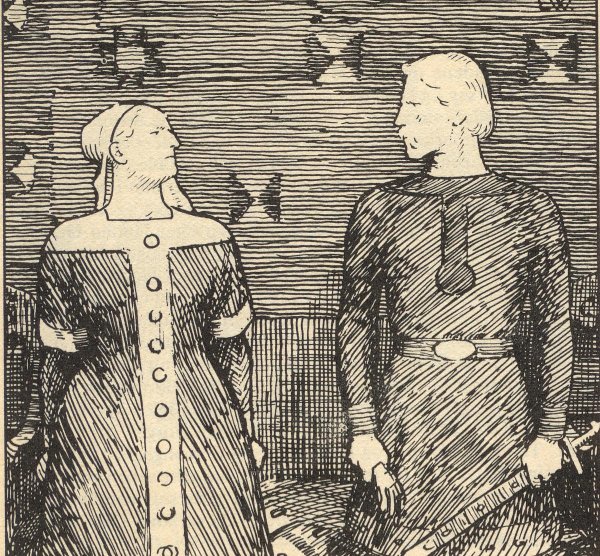In the wonderful book by Antoni Gołubiew - Bolesław the Brave - Świętosława - the sister of the brave king is mentioned.
The Scandinavians changed her name to Sigrid and added the nickname Storrada, which the English Wikipedia translates as Haughty - CLICK.
The name had to be changed because for Scandinavians Świętosława was too difficult to pronounce. And there was no shortage of opportunities to speak - Sigrid became the heroine of many Scandinavian sagas.
Google translates storrada to - great line. Absolutely right - from the Piast dynasty!
In Gołubiew's book, Świętosława appears in Bolesław's camp when he is fighting the Vikings on the island of Wolin.
Świętosława, the wife of the Swedish king Erik the Victorious, had just been widowed and wanted to find out whether she could count on support of her brother.
The answer was no, Poland is involved in wars on several fronts - cope on your own, sister.
And she did as advised...
The first thing is to find a husband - a Swede.
There were several competitors, no audiovisual message, so Świętosława invited them all to her castle at the same time - show what you are worth.
The presentations must have been very poor because after a short time the queen ordered the building in which the suitors were sleeping to be set on fire at night and all of them burned down.
Here, however, Świętosława played not very fair because she was already in love with Olaf Trygvasson, the king of Norway - CLICK.
Too bad, it happened, the suitors were burned, at least no one can accuse her of not looking for a local product, now Świętosława does not have to hide her feelings.
She sent a messenger to Olaf - come, Viking - take me!
And Olaf sailed with his fleet to Gothenburg.
Here I am Storrada, but don't expect me to come ashore, you come to me.
The Vikings built a bridge and covered it with a red carpet.
Storrad walks proudly - I'm going to my beloved - look at me.
Olaf watchd with a smile, suddenly gives a signal and the Vikings, hidden under the pier, cut the spans. The bridge collapses, Storrada falls into the water, Olaf laughs out loud - you have learned your lesson, treacherous woman!
This insult demands blood, but what can a single woman do?
Simple - propose marriage to King Sven Forkbeard of Denmark. Of course, under condition that he hits Norway.
Deal you can not throw away.
In the year 1000, Sven, supported by the Swedish king Olaf Skotkonung (Swietosława's son), attacks Norway. The main sea battle celebrated in numerous Norwegian sagas takes place near Svold - CLICK. Olaf loses most of ships and, to avoid capture, jumps from his ship into the sea.
And they saw him that much, although there are rumours that later someone encountered him in Jerusalem
Having achieved her goal, Świętosława gave birth to two sons to her Danish husband. Harald and Canute the Great were respectively kings of Denmark and Canute was also king of England - CLICK.
After the death of her husband - Sven Forkbeard - Świętosława returned to Poland, but when two years later her son Canute the Great took the English throne for good, he invited his mother to his court.
Old times, old stories, sometimes contradictory.
I have not found anywhere confirmation of the scene of flooding Świętosława described by Gołubiew. All sources mention that Olaf hit her in the face with his glove. The reason was the refusal to accept Christianity. An illustration of the meeting with Olaf below...

Source - Wikipedia
Świętosława, daughter of Dąbrówka, queen of Poland who brought Christianity to the country, was a pagan?
I think it's very likely.
This is indicated by the pagan name.
Both Olaf Tryggvason (interesting fact - he spent his childhood in Kiev) and Bolesław the Brave (interesting fact - he spent his youth at the imperial court in Aachen and witnessed the opening of Charlemagne's tomb) mercilessly suppressed pagan customs in their countries, but it was great politics - to be or not to be be on the European map.
And what was there in the soul? The woman did not have to publicly flaunt her beliefs.
Some sources say that Storrada burned only two suitors.
Only one source mentions Olaf being spotted in Jerusalem.
The Norwegian sagas attribute Sygrida Storrada's experiences to several women.
I'm not surprised, it's hard to fit it into one life, it's hard to fit it into a Norwegian head.
You have to be from the Piast family.
An example of this confusion can be found here - CLICK. The genealogy website states that Sigrid Storrada was the daughter of the Swedish warrior Tosti, but at the same time it informs that the alternative mother of Storrada's children could have been Sigrid MIEZKODOTTIR, i.e. Mieszko's daughter.
I am reminded of Father Józef Tischner's classification of truths:
- shit not the truth, some truth and the holy truth.
Personally, I prefer the writer's intuition to the glass and eye of historians or the fantasies of Norwegian storytellers.
In what they say there is some truth, but only Antoni Gołubiew gives the holy truth about Świętosława.

